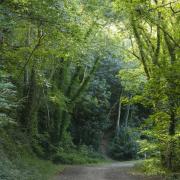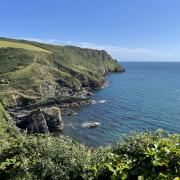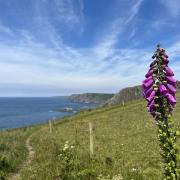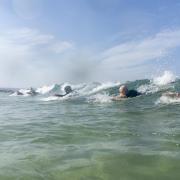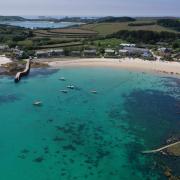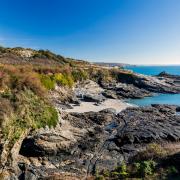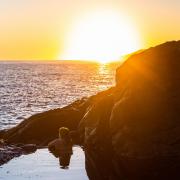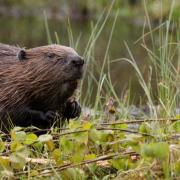Britain's coastline is currently home to 40% of the total world population of Atlantic Grey seals. We have a responsibility to protect them, but the British Divers Marine Life Rescue (BDMLR) Cornwall receives reports of harassment roughly every 15 minutes during high season. Happily, there are some very simple steps to ensure we can all care for these special animals, especially as their pupping season is now underway.

Seals spend a lot of time in the water feeding but as mammals they must come ashore for long rest periods to digest and recoup energy. Pregnant females will also haul out in summer before giving birth to their pups on land from September to January.
Seals will often panic and bolt at first sight of people, taking the first available path to escape, leading to injuries on sharp rocks which can prove fatal. Disturbed rest depletes energy and seal pups in particular can get exhausted and drown. Animal care expert Ben from the Cornish Seal Sanctuary at Gweek recommends keeping a distance of 100 metres from seals. Lizzie, a volunteer medic with BDMLR adds: ‘If they see you, you’re too close. If you are on top of the cliff path and see them below, most likely you are at a safe distance. Get binoculars out and enjoy the moment, it’s wonderful to see a seal in the wild but don’t be encouraged to get closer.’
As with livestock, dogs must always be on a lead where seals are likely to be (i.e. beaches with frequent sightings), lest they attack and injure them. It’s also dangerous for the dog, as adult seals weigh over 200lbs, have sharp teeth and claws and are known to scratch and bite. Seals, including the smaller pups, also carry zoonotic diseases which require specialist treatment for both humans and dogs.

The Seal Research Trust recommends using a zoom lens, or phone function, to take photographs, giving seals the requisite space. As seals looking into the lens means they can see you, it’s best not to capture them this way in the wild. Their reports suggest people assume the seal is smiling and sharing these images prompts others into thinking it’s ok to get close. If you do share an image, always mention in the photo commentary ‘photo taken at a safe distance with a zoom lens’.
Ben adds: ‘Don’t name the location of seal haul out sites on social media. If it becomes a tourist destination, it's detrimental to the seals’ welfare. These are their beaches and habitat they are using to follow their natural behaviours. Instagram and TikTok algorithms and trends can be really dangerous - people coming wanting pictures with seals, especially pups, because they have seen it online. ‘Seal selfies’ are an interruption of seals' wild behaviour.’
This human interference is having a direct impact on the seal population around Cornwall. It’s most dangerous during the pupping season from September to December. Pups are left on a beach for periods by the adult female so that she can feed to produce milk for the pup. Born with a white coat of fur that isn’t waterproof, the pups are most vulnerable for the first 3 weeks as they drink milk, cannot hunt or swim and are totally dependent. This is also when they look ‘cutest’, being smaller and more helpless and in danger of being photographed at close range, picked up or petted by beach goers whilst mum is away feeding.
Sadly, this behaviour has devastating results, as Ben explains: ‘The mum will have an eye on the pup from the water, if this happens, she will abandon it to preserve her own safety and presuming the pup is no longer healthy, having been tampered with. Abandoned pups become malnourished and require professional rescue to be rehabilitated and returned to the wild.’

Call for help
A lone seal pup on the beach usually isn’t in danger, just resting when mum is feeding nearby and must never be put or chased into the water. Separated from its mother it’s at real risk of malnourishment and drowning.
If concerned, look for adult seals in the water nearby. If none are visible, wait at least one to two tide cycles to see if an adult female returns for the pup. If not, then call for trained medics from BDMLR and tell them the pup’s location. ‘What 3 Words is an excellent app to let medics know exactly where they should go’ Lizzie adds. ‘They may ask you to stay at a 100m distance on the beach and encourage others to respect the animal and keep away until help arrives’.
Report inappropriate behaviour
Grey seals are protected by law, it is a crime to kill, injure or take a seal from a beach in this country (BDMLR and Cornish Seal Sanctuary have specialist licences for rehabilitation).
If witnessing harassing behaviour such as poking with sticks, throwing stones, dogs near a seal, or people directly interacting with one on the beach, call the police on 101, the Wildlife Crime Unit is there for this kind of situation. Take photos or video to give to police as evidence, to help bring perpetrators to justice. BDMLR volunteers can also come out to monitor and protect seals.
Little Extras
Small things we can all do easily make such a difference to our wildlife, like abandoning flying O rings as many seals have died from being caught in these around their neck in the ocean. Solid frisbees are much safer and just as fun! Look out for washed up monofilament net and bin it, helping seals stay safe from entanglement and our beaches clean. With a few simple practices such as these, we can all enjoy the beauty of the Cornish coast and its wildlife safely.
Report a concern
Cornish Wildlife Trust Disturbance Hotline: 0345 201 2626.
BDMLR Hotline: 01825 765546




